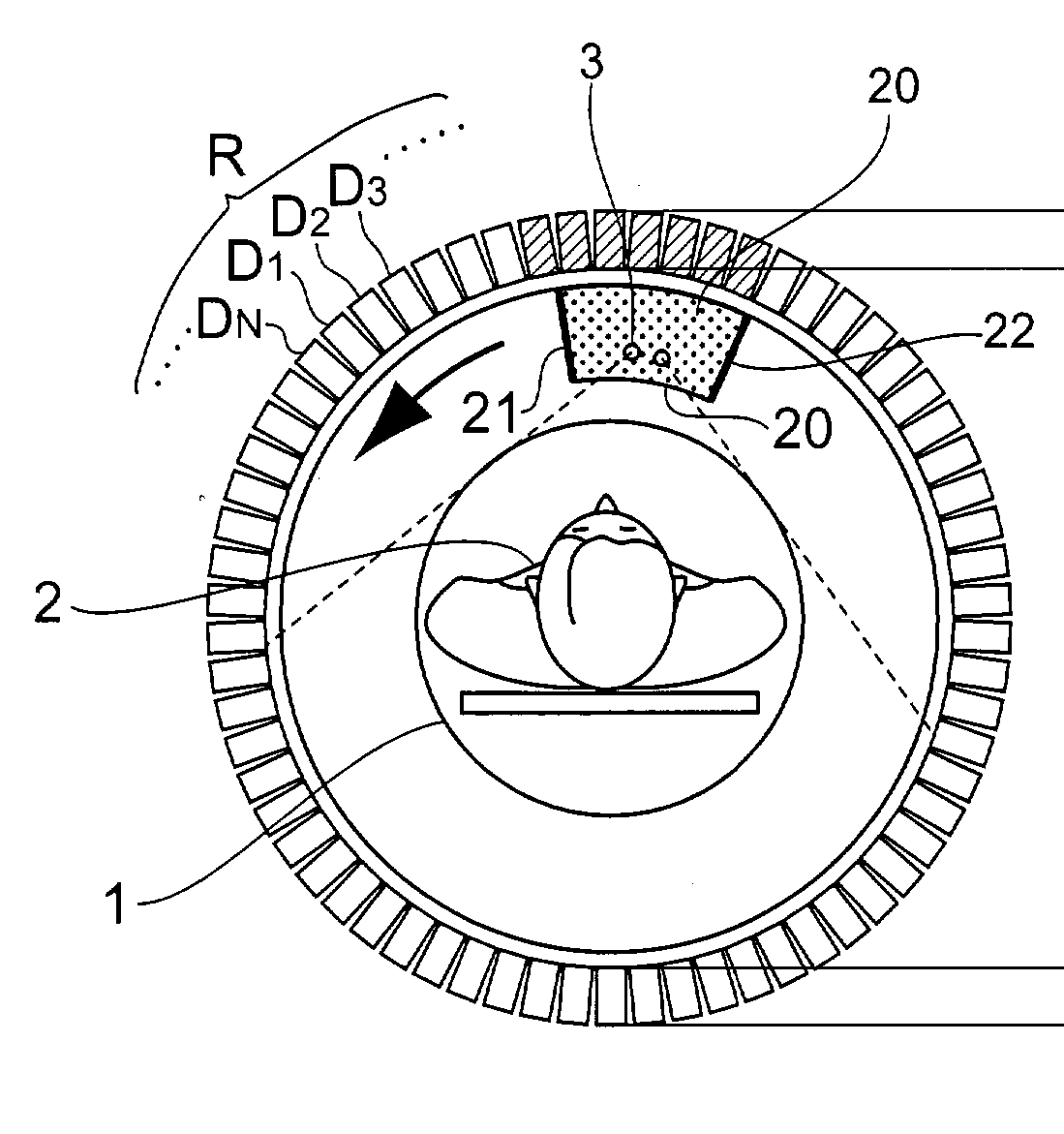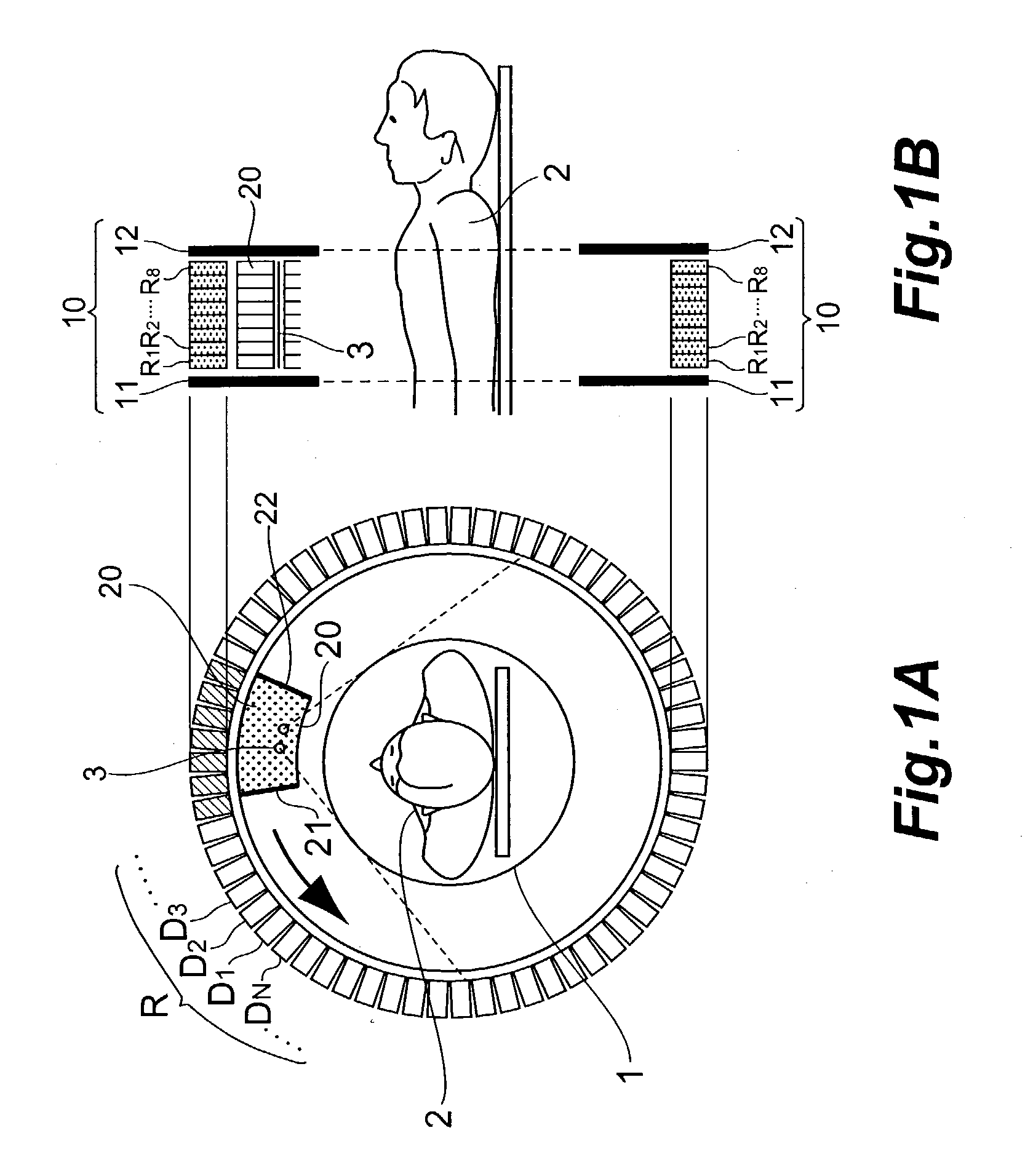Pet device
a technology of a pet and a spherical body, which is applied in the field of pet devices, can solve the problems of requiring a long time for measurement, placing an enormous burden on the subject 2, and causing the worst throughput of examination,
- Summary
- Abstract
- Description
- Claims
- Application Information
AI Technical Summary
Benefits of technology
Problems solved by technology
Method used
Image
Examples
first embodiment
[0061] (First Embodiment)
[0062] First, a PET device according to a first embodiment of the present invention is described below.
[0063] FIG. 1A and FIG. 1B are explanatory views illustrating the configuration of a detector portion and a rotating ceptor in the PET device according to the first embodiment. FIG. 1A is a view illustrating a detector portion 10 when viewed in a direction parallel to the center axis, FIG. 1B being a cross-sectional view of the detector portion 10 taken along a plane containing the center axis.
[0064] FIG. 2A and FIG. 2B are more detailed explanatory views illustrating the configuration of the rotating ceptor of the PET device according to the first embodiment, FIG. 2A being a perspective view, FIG. 2B being a cross-sectional view.
[0065] The detector portion 10 comprises detector rings R.sub.1 to R.sub.8 stacked in layers between a shield plate 11 and a shield plate 12. Each of the detector rings R has N photon detectors D.sub.1 to D.sub.N that are annularly...
second embodiment
[0101] (Second Embodiment)
[0102] Now, a PET device according to a second embodiment of the present invention will be described below. FIG. 6A and FIG. 6B are explanatory views illustrating the configuration of the detector portion 10 and the rotating ceptor 20 in a PET device according to the second embodiment. FIG. 6A is a view illustrating the detector portion 10 when viewed in a direction parallel to the center axis, FIG. 6B being a cross-sectional view of the detector portion 10 taken along a plane containing the center axis.
[0103] The PET device according to the second embodiment is different from the one according to the first embodiment in that the second embodiment is provided with the ceptor retract portion 30 having a space for retracting the rotating ceptor 20 therein, and with rotating ceptor retract means for placing the rotating ceptor 20 in the measurement field of view 1 and retracting the rotating ceptor 20 into the ceptor retract portion 30.
[0104] The PET device ac...
third embodiment
[0106] [Third Embodiment]
[0107] Now, a PET device according to a third embodiment of the present invention will be described below. FIG. 7A and FIG. 7B are explanatory views illustrating the configuration of the detector portion 10 and the rotating ceptor 20 in a PET device according to the third embodiment. FIG. 7A is a view illustrating the detector portion 10 when viewed in a direction parallel to the center axis, FIG. 7B being a cross-sectional view of the detector portion 10 taken along a plane containing the center axis.
[0108] The PET device according to the third embodiment is different from the one according to the first embodiment in the following points. That is, the PET device according to the third embodiment is provided with coarse slice collimators 13 to 15 between the shield plate 11 and the shield plate 12 of the detector portion 10, detector rings R.sub.11 to R.sub.18 and a rotating ceptor 20.sub.1 between the shield plate 11 and the slice collimator 13, detector ri...
PUM
 Login to View More
Login to View More Abstract
Description
Claims
Application Information
 Login to View More
Login to View More - R&D
- Intellectual Property
- Life Sciences
- Materials
- Tech Scout
- Unparalleled Data Quality
- Higher Quality Content
- 60% Fewer Hallucinations
Browse by: Latest US Patents, China's latest patents, Technical Efficacy Thesaurus, Application Domain, Technology Topic, Popular Technical Reports.
© 2025 PatSnap. All rights reserved.Legal|Privacy policy|Modern Slavery Act Transparency Statement|Sitemap|About US| Contact US: help@patsnap.com



